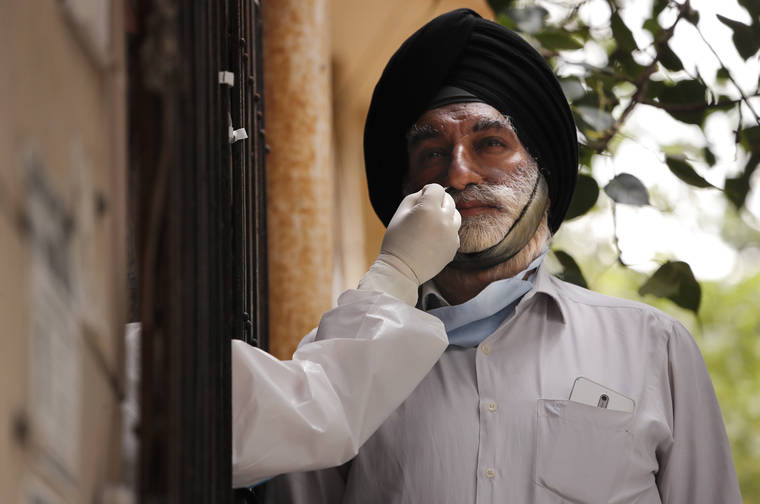SEOUL, South Korea — South Korea is banning large gatherings, closing beaches, shutting nightspots and churches and removing fans from professional sports in strict new measures announced Saturday as it battles the spread of the coronavirus.
Health Minister Park Neung-hoo announced the steps shortly after the Korea Centers for Disease Control and Prevention reported 332 new cases — the ninth straight day of triple-digit increases. The national caseload is now at 17,002, including 309 deaths.
While most of the new cases came from the densely populated Seoul metropolitan area, which has been at the center of the viral surge in recent weeks, infections were also reported in practically every major city and town, raising concerns that transmissions are slipping out of control.
The government had already imposed elevated social distancing measures in Seoul this week after resisting them for months out of economic concerns.
“We are now in a very dangerous situation that could trigger a massive nationwide spread of COVID-19,” Park said.
Churches had been a major source of new cases in the Seoul area before authorities shut them this week. Nightclubs, karaoke bars, buffet restaurants and computer gaming cafes in the greater capital region have also closed and spectators are banned again from baseball and soccer games, just weeks after teams had been allowed to sell portions of their seats.
The same measures will apply nationwide from Sunday, although Park said local governments will be permitted to exercise some level of flexibility, such as advising business shutdowns rather than enforcing them, if infections are low.
KCDC Director Jeong Eun-kyeong has endorsed even stronger restrictions. If there’s no sign that the virus spread is slowing after the weekend, she said the country should consider elevating social distancing measures to “Level 3,” which includes prohibiting gatherings of more than 10 people, shutting schools, halting professional sports and advising private companies to have employees work from home.
Yoon Taeho, a senior Health Ministry official, said the government will review the effect of the restrictions before deciding whether to strengthen them further.
As of Saturday afternoon, nearly 800 infections have been linked to a Seoul church led by a vocal critic of the country’s president. Sarang Jeil Church pastor Jun Kwang-hun was hospitalized with COVID-19 on Monday after participating in an anti-government protest last week where he shared a microphone on stage with other activists. More than 100 infections have been tied to protesters.
Police raided the church late Friday while trying to secure a more comprehensive list of its members who remain out of contact. Health workers have used cellphone location data to identify some 50,000 people who spent more than 30 minutes on the street during the protest last Saturday and have been alerting them to get tested. Around 18,000 of them have been tested, said Kwon Jun-wook, director of South Korea’s National Health Institute.
In other developments in the Asia-Pacific region:
— India has recorded another 24-hour jump in coronavirus infections as the disease spreads across the country’s southern states after plateauing in the capital and the financial center of Mumbai. The Health Ministry reported 69,878 new cases on Saturday, bringing the total to 2,975,701. Globally India has been reporting the biggest daily rise in cases for 18 consecutive days. Some 2.2 million people have recovered from the disease in India since the first case was diagnosed in late January. India has the third-highest caseload after the United States and Brazil, and its 55,794 deaths give it the fourth-highest death toll in the world. Tedros Adhanom Ghebreyesus, head of the World Health Organization, said Friday that the goal was to end the pandemic within two years of its first emergence in Wuhan, China, late last year.
— New cases of COVID-19 in Australia’s Victoria state continued to decline Saturday with 182 new infections, along with 13 deaths. It was the second day in a row in which the number of new infections has fallen below 200. Only 24 of the latest cases are without a known source, a contrast to the start of August when hundreds could not be traced. Australia’s second largest city, Melbourne, and parts of rural Victoria were placed in full lockdown in early August. It’s due to continue until Sept. 13. “Whilst tomorrow’s numbers will be for tomorrow, we are all pleased to see a ‘one’ in front of these additional case numbers, and to a certain extent, it is perhaps at that level a little quicker than I thought it might be,” Victoria Premier Daniel Andrews said. Meanwhile, an outbreak linked to a youth detention center in Queensland state has caused the state’s premier to reintroduce restrictions on public gatherings. The cluster connected to the Brisbane Youth Detention Center now stands at seven, including six confirmed on Saturday. The 127 inmates, some as young as 13, have been locked in their rooms since a 77-year-old female supervisor tested positive on Wednesday. The worker, who is now in a hospital, worked five shifts at the center while infectious. Queensland Premier Annastacia Palaszczuk told a news conference Saturday the cases are of concern because “people have been out and about in the community.”
— China on Saturday reported another 22 new cases brought by travelers from abroad, with no additional local infections. The National Health Commission said 454 people remain in treatment and 3,667 are in isolation. While local spread of the virus appears to have been contained in mainland China, the semi-autonomous southern city of Hong Kong continues to struggle with its worst outbreak since the pandemic began. The territory’s leader Carrie Lam said Friday Hong Kong will offer free coronavirus tests to its residents over a period of two weeks starting Sept. 1., in hopes of restarting the services-dependent local economy. The city’s economy contracted 9% in the second quarter of this year. A new surge in infections has more than tripled the number of cases in the city to 4,632, with 75 deaths.
———
Follow AP’s pandemic coverage at http://apnews.com/VirusOutbreak and https://apnews.com/UnderstandingtheOutbreak


